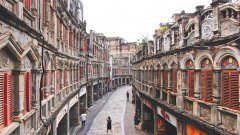Feature: The Grand Canal: a Chinese cultural conduit
By Xinhua writer Wang Jian and Feng Yuan
BEIJING, July 28 (Xinhua) -- The ancient Chinese made two great engineering wonders: the Great Wall and the Grand Canal. Though the Great Wall's function in military defence has faded over time, the Grand Canal remains a crucial conduit of cultural communication.
The Grand Canal, spanning over 2,000 kilometers between Beijing and Hangzhou, was listed as a world heritage site in 2014. Currently, the construction of the Grand Canal cultural belt is a hot topic nationwide.
Why should a man-made waterway be considered such a cultural treasure?
Zhang Shuheng, researcher with the archaeological institute of Zhejiang Province, said the canal was a pillar for the economy, social stability and government functions in ancient China.
The canal also worked to nourish the evolution of Chinese culture by enhancing communication between the south and the north.
Hangzhou resident Zhou Zhihua grew up beside the canal.
"In ancient times, areas around the Gongchen Bridge was a busy ferry terminal full of people from all walks of life, businessmen, dockmen, rickshaw drivers, vagrants...," he said.
Zhou has been a local folk opera performer for over 50 years. He said that in the early 20th century, opera performers would gather at the bridge to perform, and the boats and tea houses on the dock were ideal stages as well.
Like silk and porcelain, tea was once an important cargo transported on the canal. Tea dealers from different parts of the country gathered at Gongchen Bridge, establishing a business association.
Zhou said the association was also a charity platform that would offer food to vagrants and prepare coffins for those who died in poverty.
"People on the dock, no matter where they come from, whether rich or poor, were all willing to give," Zhou said.
Today, the hustle and bustle of Gongchen Bridge is a scene of the past, but the spirit of openness and philanthropy has become part of the local culture.
At the site of the tea association, Zhou opened a tea house. The tea house has been sending free Laba porridge to local residents during the Laba Festival over the past six years.
Also sitting on the Grand Canal is the city of Suzhou, sometimes called the "Venice of the East" for its abundant waterways.
Andrew Shaw, once a BBC reporter in Britain, found his spiritual home in the Chinese city.
Nine years ago, Shaw, mesmerized by the eastern jade culture, quit his job and traveled to Suzhou to become a jade carver.
Since the mid Qing Dynasty (1616-1912), Suzhou has been the center of jade carving in China. Local craftsmen would travel to Beijing on the canal to serve the emperors.
Shaw went to Xiangwangnong, a gathering place of local jade workshops, and visited door-to-door to look for a mentor. Finally, he became an apprentice in one of the workshops.
Today he owns a workshop and his art works are usually a blend of eastern and western culture.
"Jade is the heart of Chinese culture, it represents the perfect personality - mild, tolerant and pure," Shaw said.
On the bank of the Grand Canal, Jessica Doolin, 27, from Ireland, is pursuing her dream to be an acrobat.
Wuqiao county of Cangzhou city in Hebei Province is a cradle of acrobatics. In the past, performers traveled along the Grand Canal to perform around the country and even abroad.
Doolin, a former hairdresser, fell in love with the art and made up her mind to be a performer five years ago when watching an acrobatic performance.
She is now the oldest student in Wuqiao acrobatics school.
"Being a late starter means I have to work harder," she said. In Wuqiao she has received unreserved consideration and help.
Cangzhou is also a cradle of Chinese kungfu. Many kungfu masters in the area worked as guards to protect travelers and cargo on the canal.
Today the Cangzhou section of the canal has almost dried up. The Grand Canal is only partly in use, and its transport function has been fading with the development of modern transport.
However, as a cultural bond connecting different parts of China, and China to world, the importance of the Grand Canal has not been lessened.
Local governments along the canal are coming up with all sorts of measures to protect this cultural gem.
A Grand Canal protection regulation was enacted in Hangzhou in May; in the city of Yangzhou, technologies such as remote sensing and big data have been applied to strengthen protection; the government of Beijing is working on a blueprint of Grand Canal cultural belt protection and construction. The list goes on.
In the art and crafts museum under Gongchen Bridge, ancient craftsmanship such as paper umbrellas, silk fans and paper cutting are demonstrated.
Paper cutting master Fang Jianguo has a workshop in the museum where there are works both in ancient style and with modern elements.
The work he is most proud of is themed on the G20 Hangzhou summit, a piece he spent two months working on.
During the past six years, Shaw has introduced jade artists from different countries to join the annual jade carving exhibitions in Suzhou. Last year, Andrew Shaw taught two French apprentices, who spent a year in his workshop.
"Communication and exchange are key to keeping culture alive and evolving," he said.















